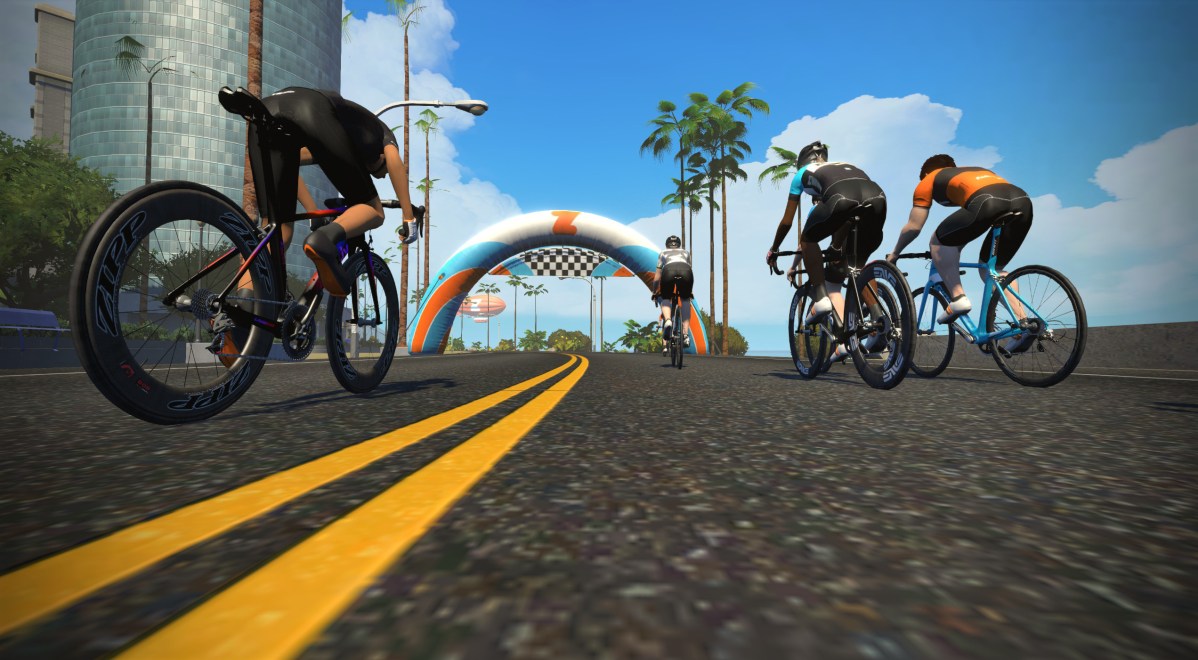
Last winter, I found myself suffering from a lack of sunshine, not realizing how lucky I was to be unfamiliar with the term “governmental quarantine.” Looking for a solution, I decided to check out virtual cycling app Zwift.
I’d heard about Zwift before, but the cycling video game sounded a little ridiculous to me. Video games are for epic quests and blowing up the undead, not for fitness. Plus, the best part of cycling is getting outside. Being in the elements, smelling the smells and seeing the sites, is amazing. To think I could replace all that with an iPad was ludicrous.
But going outside wasn’t appealing, either. One cold, rainy day, I decided to give the 30-day free trial a go. I hooked my bike up to the stationary trainer, filled some water bottles to the brim, and fired up a fan to blow my winter blues away.
Then, I started spinning.
Normally, spinning away on a turbo trainer while staring at a wall is among the most brutal exercise endeavors you can embark on. The mind-numbing boredom sets in within the first few minutes and so begins an epic internal battle that, at least for me, results in a profanity-laced inner monologue that would make the South Park kids blush.

But with Zwift, things were different. Instead of a wall, I was watching my avatar spin his little virtual legs right along with me. When I stopped, he stopped. So began the immediate camaraderie that was an incentive to keep on going. Now, I was cycling for two! Like a proud new father, I couldn’t let my little cycling buddy get shown up by D. Smith from the U.K. because … well, video games? I’m sure the competitive spirit that kept me spinning is no different from that of gamers who put massive hours in games like World of Warcraft. I just wanted the little cyclist on my screen to win.
I’m sure the competitive spirit that kept me spinning is no different from that of gamers who put massive hours in games like World of Warcraft.
I was immediately sucked in. While I still missed the outdoors, Zwift had perks. I didn’t have to deal with traffic lights, stop signs, semi-trucks, and texting drivers. I could also get a solid hour workout that, if I was going outside, would be book-ended by the usual bike checks, kit decisions, and other minuscule tasks that seem to eat up a lunch hour in no time.
I could hop on, get my ride in, and go on with my day feeling reinvigorated because I just crushed my personal record on the Sand and Sequoias route in one of Zwift’s virtual world’s, Watopia.

After a month of doing nothing but solo rides, I started to dig into everything that Zwift had to offer. In addition to the worlds and routes that provide a change of scenery, like the dinosaurs in Watopia or the Tower Bridge in London, Zwift has a whole host of dedicated workouts, daily group rides, events, and races.
The workouts let you focus on specific fitness metrics and dial in where you need to improve while introducing you to your functional threshold power, or FTP. This is the watts you can put out over an hour. Watts, as in electricity? Yep, that’s basically correct. Watts is used as a measurement of the power you create when pedaling. It sounds nerdy (and it is), but I became obsessed by how many watts I could throw down, and with all the metrics Zwift provides.

Tracking your progress with watts is one of, if not the, most accurate way to gauge your fitness. Unlike your heart rate, which can jump around due to a slew of environmental factors, your power output is a concrete way of measuring just how well you stack up against the competition.
I wouldn’t consider myself an overly competitive person. I grew up playing some sports, but at the end of the day, my attitude toward most games is laissez-faire. Yet Zwift awakened a sleeping giant of ambition to get faster and stronger. While looking to earn more points to upgrade my virtual bike, I was dropping pounds like nobody’s business, and my legs started to look a little less chicken-ish.
Zwift awakened a sleeping giant of ambition to get faster and stronger.
My newfound fitness and cycling obsession was a welcome addition to my weekly routine. Even as the weather turned warm, I still found myself riding indoors on Zwift once or twice a week because I enjoyed it that much. When the cold weather returned last fall, I was ready with a gameplan to keep on seeing gains all through winter in preparation for the big real-world races I was going to be doing in 2020. However, the pandemic had other plans, and the events I was planning on riding in have been rescheduled or canceled altogether.
But I’m still Zwifting, and at any given moment, so are thousands of other cyclists. In fact, in the past month Zwift’s biggest benefit hasn’t been the fitness metrics, but the community of riders. Participating in weekly meetup rides and interacting with people from all over the world has been a much-needed, overwhelmingly positive social outlet. From dad jokes to words of encouragement, the social rides offer a connection that isn’t possible otherwise, given the current climate.

Not all the cyclists on Zwift are Joe Schmos. Tons of professional riders use Zwift and some even host rides. This offers a unique opportunity to go spin a few laps with pros like Mark Cavendish and Chloe Dygert, or YouTubers like The Vegan Cyclist. And it’s this community that makes Zwift more than just a virtual training program.
There are other virtual training apps out there that I haven’t tried, like Rouvy, TrainerRoad or SufferFest, but right now I’m having way too much fun on Zwift to make a switch. Coupling that with the fact that I’m in better shape now than I’ve ever been and I’m super pumped to finally get the Tron bike, I don’t think I’ll be switching anytime soon.


